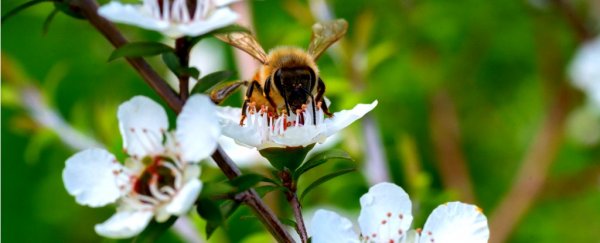New research has discovered that a variety of Australian honey has the same, potent antibacterial properties as the premium New Zealand mānuka version.
With antibiotic resistance on the rise, researchers are turning to alternative ways to fight pathogens. One of those products is mānuka honey – honey derived from the flowering mānuka plant (Leptospermum scoparium) from New Zealand.
You won't be prescribed expensive honey instead of antibiotics for an infection anytime soon, although it is effective at inhibiting bacterial growth on surfaces and possibly skin.
However, the demand for mānuka honey is still much higher than the amount the bees can produce – only 1,700 tons (1,540 tonnes) of mānuka honey is produced a year in New Zealand, with over 10,000 tons (9,071 tonnes) being sold as "genuine" mānuka honey.
Researchers led by Liz Harry at the University of Technology Sydney (UTS) have now shown that an Australian honey, made from similar Leptospermum trees, have the same antibacterial properties and could help meet some of the huge demand.
"These findings put Australian mānuka honey on the international radar at a time when antibiotic resistance is recognised as a global crisis," said one of the researchers, Nural Cokcetin, from the ithree institute at UTS.
"All honeys have different flavours and medicinal properties, depending on the flowers bees visit for nectar."
"What makes mānuka honey so special is the exceptionally high level of stable antibacterial activity that arises from a naturally occurring compound in the nectar of mānuka flowers. It's the ingredient we know acts against golden staph and other superbugs resistant to current antibiotics," she added.
The compound in both the New Zealand and Australian mānuka honeys is called methylglyoxal, and comes from another naturally occurring compound in the nectar of these flowers.
Recent studies have shown that the honey is an effective antibacterial in vitro (in a petri dish), and other research has shown it may be effective in wound dressing to inhibit the growth of bacteria, although that is still inconclusive.
"It is thrilling to be able to use our research expertise and knowledge to help the bee industry and to address the antibiotic resistance crisis," said Harry.
"Honey not only kills bacteria on contact but we have shown previously that bacteria don't become resistant to honey."
The research means that Australian beekeepers can produce more medicinally active honey to supplement the New Zealand market.
"Our study provides the proof for what we've long assumed – that this compound, methylglyoxal (MGO), is present in high levels in Australian mānuka honeys," Cokcetin said.
"We've also shown that the activity of Australian mānuka honeys has remained unchanged over seven years from harvest, which has huge implications for extending the shelf life of medicinal honey products."
Australia is home to 83 of the 87 known Leptospermum species of plants, and is free of the varroa mite, which New Zealand beekeepers, and much of the rest of the beekeeping world struggles with.
"That the manuka varieties in Australia are just as active as those in New Zealand, and have essentially the same chemical profile, will add significant value to Australian honey for beekeepers and provide a plentiful supply of medicinal honey," said Harry.
In a world where antibiotics are fast dwindling, it's exciting that something as simple as honey might be useful in the superbug fight.
The new research has been published in PLOS ONE.
UTS Science is a sponsor of ScienceAlert. Find out more about their research.
